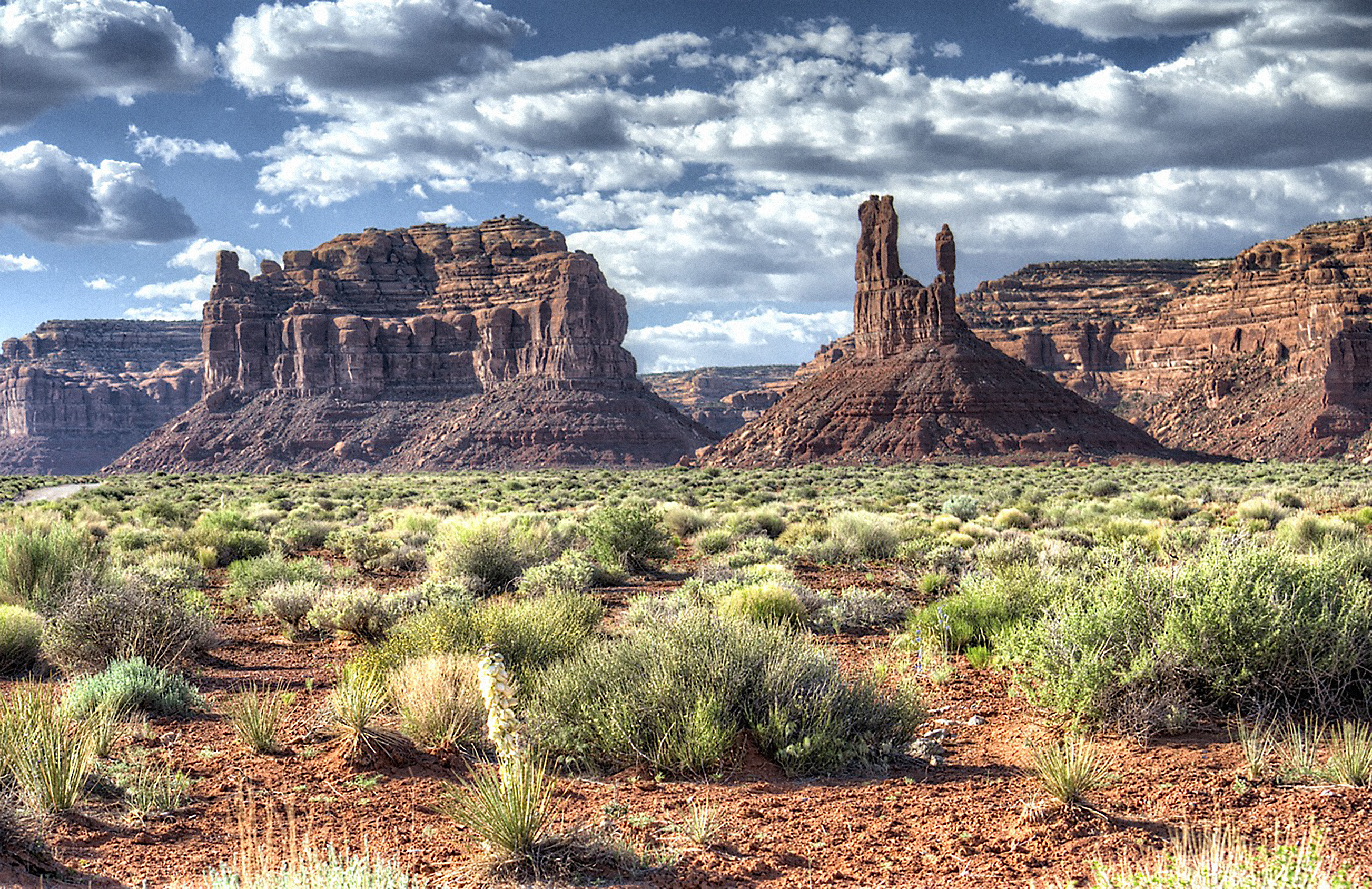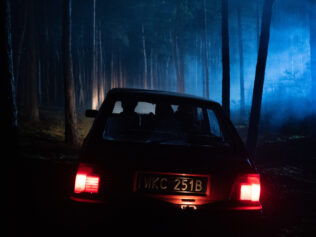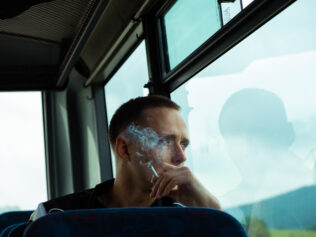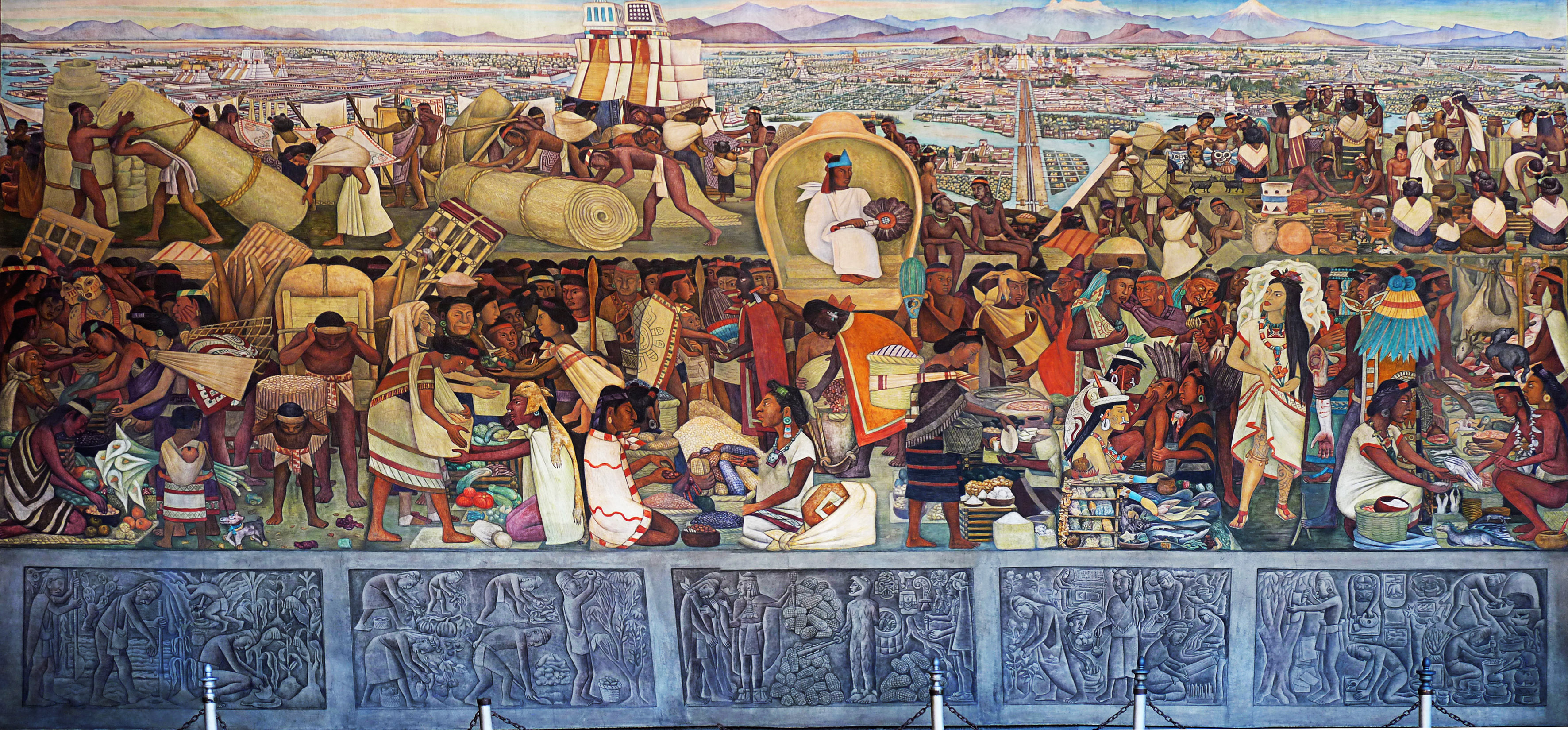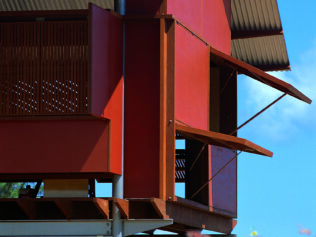
The scenic and sublime Monument Valley, part of the Colorado Plateau, lies within the territory of the Navajo Nation Reservation. The Valley of the Gods, located to the north of Monument Valley, is part of the same geological system and a vast natural temple sacred to the Navajo. It is also where Lech Majewski shot his last film.
I spoke with Lech Majewski at the Polish Film Festival in Gdynia after the premiere of Valley of the Gods. The latest film by the man behind Life Hurts and The Mill and the Cross was finally shown in Polish cinemas after having been delayed by the pandemic. The movie draws from an ancient legend of the Navajo, whose gods live inside the rock formations of the titular valley.
Jan Pelczar: From the first few takes of Valley of the Gods, the audience is hypnotized by the captivating vistas you found within the Navajo territory.
Lech Majewski: My films take a long time to be made. The valley inhabited by the Navajo has fascinated me for years. And the idea behind this film has been budding and growing for an equally long time. Towards the end of the 1980s, in collaboration with David Lynch’s Propaganda Films, I started pre-production on the movie that would become Gospel According to Harry. We originally intended to shoot it in the desert, somewhere in the western part of the United States. I was appointed a guide, or rather a location scout, with whom I traveled across probably all the deserts in this region of America. We drove over 8000 kilometres. I simply didn’t know which desert to choose. I showed Lynch a fragment of my earlier film, The Knight, that we’d shot among the white sand dunes near Łeba in northern Poland. He loved it and that’s basically why we shot Gospel there. But my strange and wonderful ramble across the deserts of the western US was not in vain. It was then that I first found myself in the Valley of the Gods, this sacred Navajo area, which left an indelible impression on me. I knew, felt, I had to do something there – and I did, even though it took 30 years.
So all it took, after all those years, was to return there?
We couldn’t just rush in there and start shooting, no. To capture the enchanting and epic vastness of the Valley of the Gods, you need a lot of preparation. You wait for the light to be just right and then there are some special concerns. Often quite costly. The necessary equipment is very expensive – say, drones. In the US, to fly a drone, you need to be a helicopter pilot or to have a special drone pilot permit or certificate. We were assigned particular spots from which our camera drones could take off. They could not fly higher or farther than a certain specified radius or range, and these weren’t casual suggestions. No, they were official, strictly-observed guidelines that had to be obeyed. If you don’t do that, you lose your license. Every drone has a hologram that transmits all the location data, so the authorities can find it and oversee its movements. It would seem it’s a simple affair – you drive to the location and shoot – but it turns out getting your stills, your footage just right takes a lot of time and a lot of work.
The American officials were not happy you wanted to make your film there?
We were shooting in the Navajo Nation. It’s a territory where US agencies, federal or state, have no authority. It remains under the sole jurisdiction of Native Americans and getting the permits we needed from them didn’t really come under any particularly logical norms – at least, that is to say, in the light of the conventions assumed by the West. It had more to do with what is more important there – religious laws, magical rules, tradition and customs. Our understanding of the world, the way we perceive law and order, hasn’t really seeped that much into the Navajo Nation. Its inhabitants are peculiar people who adhere to some very deeply-held beliefs about the world – what it is and what rules govern it. They see things we don’t. When I was with them, they would constantly point to things they believed existed. I would look and see nothing.
What were they showing you?
Mostly signs hidden in the rocks. Signs and symbols that, to them, were clear and legible as if written in capital letters. And yet I saw nothing, even though I teach symbols and their hidden language at many universities around the world. It was a fascinating experience to move across this beautiful space with people who think in a very different way, who read reality from a standpoint alien to mine. They taught me a lot.
How did this education look during your travels?
It was always practical. Teaching by doing. Learning from nature, drawing in natural knowledge. One day, I was walking with a Native American guide who suddenly stopped in his tracks. I followed suit and asked him: “Why are we stopping?” We were wandering across flat terrain, a windswept desert with rocky rough beneath it. There was dust in the air. I asked him the question and he placed his finger on my lips to silence me. So, I’m standing there, he’s standing there, waiting, and I have no idea what’s going on. After a moment he says: “OK, we can move on.” So, I ask him: “But why did we stop?” To which he says: “You didn’t see it, but we had to wait for the spirits of animals who were hunted here to pass.” At first, I thought he was pulling my leg, but later, on many occasions, I realized he really wasn’t.
How can you be so sure?
The Navajos feel this particular kind of connection with their land. The entire Valley of the Gods is one giant temple to them. One mustn’t desecrate it, defile it by littering, throwing cigarette butts on the ground, spitting or relieving oneself. One mustn’t do anything they deem wrong.
Why?
Because the land is the domain of their ancestors. Dead Navajos. The people there believe that their ancestral spirits inhabit the earth there. Their not being there physically has nothing to do with it. What matters are those nexuses of energy that remain in the air. I do myself value and appreciate the immaterial, incorporeal things, so I thought we were quite alike, me and the Navajos I met, but in time, I arrived at the conclusion that our attitudes towards nature and natural forces were different. To us, people raised in the West, the air is something transparent, invisible. To the Navajos, however, it’s neither transparent nor uniform. They see it as a world of movement. They also feel this astonishing connection to the earth, the ground below their feet. If you’re Navajo, you don’t – can’t – just walk straight ahead through the desert, however empty it may appear. They see things one must avoid, walk around. We were around two-and-a-half kilometres above sea level. The country there is dry, the climate arid. It resembled the Atacama Desert in South America. The wind blows all the time, cleansing this vastness. I spent a most incredible night there.
What happened?
There was a full moon in the sky. We were shooting some night scenes, so we weren’t really paying much attention to the sky. It was only when we returned to our Native American base, a place with no artificial light whatsoever, that my camera operator and I looked up. You wouldn’t have been able to put one more star in there. The night sky was white with them. White with stars. As if the Milky Way had taken over the entirety of the upper atmosphere. A white firmament. Amazing! We don’t really see the night sky on regular nights. It’s because the lights of our cities hide it from us. Make it seem empty. Sometimes, when we are able to spot a few stars, maybe the moon, we tell ourselves it must be true wilderness where we are. I think no Western city dweller has ever had the chance to witness the Milky Way the way we saw it, so bright and clear, in the Navajo Nation desert. Well, mountaineers, maybe. They might have this privilege. But in the urbanized world there are no such sights. The Navajos spend their entire lives under this starry vault. The nearest light-polluted city whose glow obscures the night sky is 289 kilometres from Monument Valley. It’s a long way. In the desert, nothing distorts the view. The sky there, in this sanctuary, this snowless snow globe of flawless glass, where the air is crystal-clear, is an incredible sight. We were so enchanted, so astounded and dumbstruck, we just pulled the chairs from inside our bungalows and stared at it for hours. It was very humbling. A lesson in humility for a man from a densely-populated, industrialized corner of the world.
Does travelling through Navajo territory by day also provides such sensations?
Even today you can feel you’re entering a place where the flow of time has stopped, a primal place inhabited by a chthonic people, real people rooted in that part of the world since times truly immemorial. Since prehistoric times. You sense it, you feel the primordial nature of this place, the solemnity. It hasn’t been spoiled by cheap commercialism. The Navajos aren’t really interested in profiting from tourism. They’ve built a few enclaves where outsiders can stay, but the Navajos themselves, especially those who still breed mustangs, live the same way their ancestors did. Without sewerage, without electricity. No creature comforts. Their only weakness seems to be cars, especially pickup trucks, which appear to be the only borrowing, the only transplant, from the West.
Valley of the Gods proves that nature provides special effects much more incredible and spectacular than those rendered on computers. What seems equally curious is Navajo mythology.
Navajo mythology and their equivalent of the book of Genesis could be compared to grand European poetry. To me, it resembles surrealist poetry, but some seven times more surreal. French poetry written in that vein doesn’t even approach its level of intensity and convolutedness. The imagery in Navajo primal myths is far more complex and abstruse. As a poet, I can only express my admiration for the way they turn their phrases. “This mountain has been pinned to the earth with the sharpest of rainbows.” Pinning mountains to the earth is an important ritual in itself. When someone from the tribe falls ill, they don’t call a doctor. A medicine man is summoned instead, a shaman. The medicine man has to walk around a holy mountain, which takes him an entire day, and symbolically pin it to the ground with a stick on each side. Then he returns to his patient and spends four days and four nights singing by his bed. The medicine man buys time necessary for this kind of healing song thanks to the pinning down of the mountain. This way, it can’t leave while he sings. To a white man, this sounds like magic, like a ridiculous superstition, but to the Navajos, this ritual is absolutely essential. They won’t back down from it even if the white man tries to shame or ridicule them, saying what they do is illogical, as mountains haven’t ever been known to move. During our conversation on this subject, my guide asked me: “So why does the ground shake so much in Los Angeles? It quakes almost all the time. Here, it doesn’t.” It’s hard to dispute such an argument.
Despite the extraordinary beauty of the Navajo Nation territory, you decided to juxtapose it with European – Polish – interiors. We see the chambers and gardens of the Książ Castle, the Czocha Castle, as well as the interiors of the Cistercian monastery of Lubiąż Abbey.
That’s because Valley of the Gods is a film about contrasts. I didn’t want to tell a story about the Navajos. I wanted a metaphorical image. I wanted to show people living in a cultural enclave surrounded by advanced civilization. The American super-civilization. The entire world does nothing but imitate it – the Chinese, the Koreans, the Russians all try to adopt and adapt American culture and re-create it in their own back yards. Tall buildings, skyscrapers, urban planning, the environment we all live in – it’s all a copy of the American civilizational achievements, a re-creation of American patterns of behaviour in different spaces. For example, the way we go to the movies has been borrowed from America. It’s the American model now. There are no European cinemas left apart from the smaller, arthouse cinemas. This sector of entertainment is dominated by the American-style multiplexes. A cinema is understood nowadays as a many-screened affair in the middle of a shopping mall with the same kind of mindless chaff shown on every screen. Comic-book CGI FX-porn. Mandatory popcorn and Coke to top the experience off.
American culture is particularly aggressive and easily digestible. The Navajos live in the middle of it, and yet they don’t give in to it. The inherent irony in all that is, if we look at the richest people in the US – a few of whom I had the chance to meet, for instance when I was working on Basquiat, because it’s of course the richest of the rich who collect modern art – we see that when they build their palaces, they try to re-create European architecture. And if they manage to copy some European architectural monument, they fill it wall to wall with vintage or antique furniture bought at auctions, only to reinforce the hyper-real impression of historicity. That’s exactly what Citizen Kane’s William R. Hearst did. First, he bought half of Europe and then tried to copy the interiors of Venice or Seville in his mansion. That’s why, for my film, I came up with the character of the richest man in the world, using the biographies of John P. Getty and Hearst – two European architecture aficionados – for inspiration. And that led me to shoot the interior scenes in some magnificent Polish places of interest, architectural monuments the world has not heard of, ones never before used in film. After the screenings of Valley of the Gods, American audiences ask me where the interior scenes were shot, and when I tell them they were done in Poland, few people tend to believe me.
Yet stars such as John Malkovich and Josh Hartnett seem to believe you are a director worth working with.
Actors know I’m an artist, a man of visual arts. They’ve been to my exhibitions; they are aware that my works are displayed in art galleries and museums. They’ve seen them at the Venice Biennale or in New York’s MoMA. They seem to like my creative visuals. It’s a kind of mutual understanding. One can find unfulfilled artists among actors – hidden visual talents. They are legion. Take David Lynch, for instance. He paints. In his case, as was the case with Andrzej Wajda, painting influences the visuals of his films. There’s this heightened awareness, a sharper perspective. This sort of background makes it easier for painters and other visual artists to work on set than it would be for a literature or linguistics specialist – cinema deals with pictures first and foremost. One can say so much without dialogue.
There’s this proverb that a picture is worth a thousand words. When I was producing Basquiat, I insisted that Julian Schnabel – who is a painter, not a professional filmmaker – was hired to direct it. Dennis Hopper, who starred in Basquiat, was himself a talented photographer and painter. David Bowie, who played Andy Warhol in the picture, had studied art and design before turning himself into a work of art. He confessed to me once that this had been his intention ever since he’d started his artistic career, and, indeed, he managed to become an icon of a new, groovy and totally far-out current in music and art. Many other film-makers and musicians are also painters – like Tony Curtis and Anthony Quinn. Robert Redford works closely with MoMA. When the curator of my first American retrospective at MoMa showed him The Mill and the Cross, which at that time was still in the final stage of editing, Redford suggested the picture be given its world premiere at the Sundance Film Festival. There are easels and paintings everywhere in Redford’s house. His wife is a painter and he paints as well. Yet, he has little formal artistic education. Many other famous actors collect art. Sylvester Stallone’s personal collection is very impressive, as is Steve Martin’s – and these are just examples. There are very many art lovers among actors.
You managed to convince the Navajos, usually rather distrustful of outsiders, to help you with your work.
The Navajos knew my interest in their culture and land was not a passing thing. We tend to associate America with civilization, breathtaking landscapes, and hundreds upon hundreds of kilometres of straight roads. Every couple of hundred kilometres, the landscape changes dramatically, and sometimes it seems to be some sort of a geographical relic from the fifth or sixth day of Creation. As if it was still being made somehow. Shaped. I’d been fascinated by Navajo culture and their highly original mythology for years. They opened their doors for me because I treated their culture with humility. If you read into their origin and creation myths, you’ll learn that, in the beginning, the sky was made of rock. A falcon flew up to that rock and started pecking at it, eventually, making a hole in the rock. When air got into that hole, out crawled blue ants that got down to the earth. Those ants play the roles of Adam and Eve in that mythology. It’s simultaneously a very exotic and somehow familiar trope.
In mediaeval European poetry, authors would anthropomorphize the landscape. Lakes would be eyes, reed thickets would be eyelashes. In Renaissance painting, rocks would symbolize the body of Christ, and cracks in those rocks – his wounds. Navajos use such spatial metaphors to describe all the terrain around them. They believe they are surrounded by the power of the gods and the sources of this power. It wasn’t an accident that, during World War II, when the US Army needed a cipher to encode important secret transmissions, this cryptographic role was entrusted to the so-called windtalkers, Navajo soldiers who spoke in their native language that proved an unbreakable code to enemy spies. It’s proof of how primal and unique their culture is.
Parts of this interview have been edited and condensed for clarity and brevity.
Lech Majewski:
One of the best-known film directors from Poland. Lech Majewski writes screenplays, opera libretti, and novels; he designs film sets, composes music, and sometimes works as a producer. He has won many prestigious awards. He lives in the US.
Translated from the Polish by Karolina Sofulak


